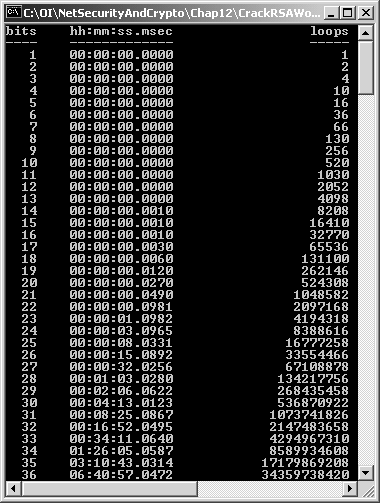The CrackRSAWorkFactorDemo Example Program
| The CrackRSAWorkFactorDemo example shows the exponential growth in time required to crack RSA. Figure B-1 shows the output from this program. These results are from a 900 MHz PC. Figure B-1. Cracking RSA work factor demo. If you want to compare these results on your own machine, and you want to know your machine's clock speed, see the following using Regedt32.exe . HKEY_LOCAL_MACHINE/HARDWARE/DESCRIPTION/System/CentralProcessor/0 For numbers up to 13 bits, less than one millisecond is required. When 22 bits are used, it takes almost one second; 28 bits takes an hour ; and if you had the patience, you would see that 38 bits takes more than a day. How many bits would take a human lifetime? Assume that you would live 2^15 = 32768 days, which is 89 years and about 9 months, just a few years higher than average life expectancy in most of the developed world. If 38 bits takes more than one day, then 53 = 38 + 15 (multiplying is done by adding exponents) will take considerably more than a human lifetime. Here is the source code for this example program. unsafe static void Main(string[] args) { //initialize prime p mpz_struct p; GmpWrapper.__gmpz_init(&p); //initialize prime q mpz_struct q; GmpWrapper.__gmpz_init(&q); //initialize pq mpz_struct pq; GmpWrapper.__gmpz_init(&pq); //string representation of n-bit binary number String strBits = "1"; Console.WriteLine( "bits hh:mm:ss.msec loops"); Console.WriteLine( "---- ------------- -----"); //iterate over n-bit binary numbers 2^1 to 2^256 for (ulong n= 1; n<=256; n++) { //get p = next prime after 2^n GmpWrapper.__gmpz_set_str(&p, strBits, 2); GmpWrapper.__gmpz_nextprime(&p, &p); //get q = next prime after p GmpWrapper.__gmpz_nextprime(&q, &p); //get product of primes pq = p*q GmpWrapper.__gmpz_mul(&pq, &p, &q); //display number of bits n Console.Write("{0,4} ", n); //do the factoring work and show loop count WorkFactor(&pq); //one more bit next time around strBits = strBits + "0"; } } unsafe static void WorkFactor(mpz_struct* pq) { //initialize candidate mpz_struct candidate; GmpWrapper.__gmpz_init(&candidate); GmpWrapper.__gmpz_set_ui(&candidate, 2); DateTime dtStart = DateTime.Now; //brute force search while (true) { if (GmpWrapper.__gmpz_divisible_p( pq, &candidate) != 0) break; //factor found GmpWrapper.__gmpz_add_ui ( &candidate, &candidate, 1L); } DateTime dtEnd = DateTime.Now; TimeSpan ts = dtEnd-dtStart; Console.Write( "{0,2:d2}:{1,2:d2}:{2,2:d2}.{3,2:d4} ", ts.Hours, ts.Minutes, ts.Seconds, ts.Milliseconds); GmpWrapper.__gmpz_sub_ui( &candidate, &candidate, 1); String str = GmpWrapper.__gmpz_get_str( null, 10, &candidate); Console.WriteLine("{0,18}", str); } |
EAN: 2147483647
Pages: 126
